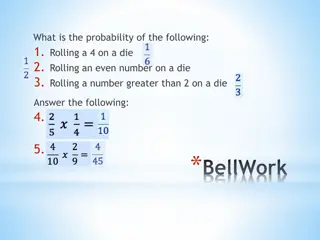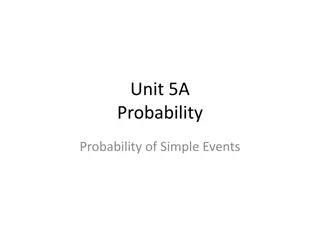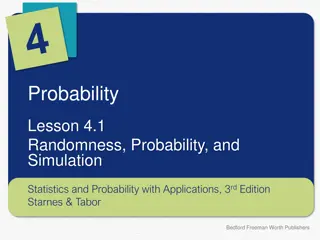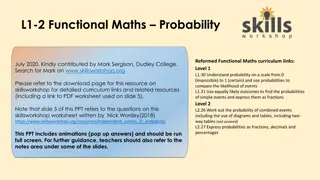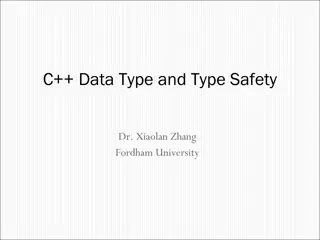Understanding Probability with Dr. Zhang at Fordham University
Dive into the world of probability with Dr. Zhang at Fordham University. Explore the basics of experiments, events, and sample spaces, learn how to calculate probabilities using counting methods, rules, and distributions. Understand concepts like conditional probability and the Bernoulli process through intuitive examples, and grasp terminology such as experiments, outcomes, and sample space. Enhance your probability skills step by step with practical explanations and visual aids.
Download Presentation

Please find below an Image/Link to download the presentation.
The content on the website is provided AS IS for your information and personal use only. It may not be sold, licensed, or shared on other websites without obtaining consent from the author. Download presentation by click this link. If you encounter any issues during the download, it is possible that the publisher has removed the file from their server.
E N D
Presentation Transcript
Probability Dr. Zhang Fordham Univ. 1
Probability: outline Introduction Experiment, event, sample space Probability of events Calculate Probability Through counting Sum rule and general sum rule Product rule and general product rule Conditional probability Probability distribution function Bernoulli process 2
Start with our intuition What s the probability/odd/chance of getting head when tossing a coin? 0.5 if it s a fair coin. getting a number larger than 4 with a roll of a die ? 2/6=1/3, if the die is fair one drawing either the ace of clubs or the queen of diamonds from a deck of cards (52) ? 2/52 3
Our approach Divide # of outcomes of interests by total # of possible outcomes Hidden assumptions: different outcomes are equally likely to happen Fair coin (head and tail) Fair dice Each card is equally likely to be drawn 4
Another example In your history class, there are 24 people. Professor randomly picks 2 students to quiz them. What s the probability that you will be picked ? Total # of outcomes? # of outcomes with you being picked? 5
Terminology: Experiment, Sample Space Experiment: action that have a measurable outcome, e.g., : Toss coins, draw cards, roll dices, pick a student from the class Outcome: result of the experiment For tossing a coin, outcomes are getting a head, H, or getting a tail, T. For tossing a coin twice, outcomes are HH, HT, TH, or TT. When picking two students to quiz, outcomes are subsets of size two Sample space of an experiment: the set that contains all possible outcomes of the experiment, denoted by S. Tossing a coin once: sample space is {H,T} Rolling a dice: sample space is {1,2,3,4,5,6} . S is universe set as it includes all possible outcomes Venn Diagram S outcomes 6
Example When the professor picks 2 students (to quiz) from a class of 24 students What s the sample space? All the different outcomes of picking 2 students out of 24 How many possible outcomes are there? That is same as asking How many different outcomes are possible when picking 2 students from a class of 24 students? It s a counting problem! C(24,2): order does not matter 7
Events Event : a subset of sample space S getting number larger than 4 is an event for rolling a die experiment you are picked to take quiz is an event for picking two students to quiz An event is said to occur if an outcome in the subset occurs Some special events: Elementary event: event that contains exactly one outcome { }: null event S: sure event Getting a number larger than 4 1 S 5 2 4 3 6 Rolling a die experiment Getting a number larger than 4 occurs if 5 or 6 occurs 8
(Discrete) Probability If sample space S is a finite set of equally likely outcomes, then the probability of event E occurs, Pr(E) is defined as: Likelihood or chance that the event occurs, e.g., if one repeats experiment for many times, frequency that the event happens Note: sometimes we write P(E). It should be clear from context whether P stands for probability or power set This captures our intuition of probability. 9
Example When the professor picks 2 students (to quiz) from a class of 24 students What s the sample space? All the different outcomes of picking 2 students out of 24 How many possible outcomes are there? |S| = C(24,2) Event of interest: you are one of the two being picked How many outcomes in the event ? i.e., how many outcomes have you as one of the two picked ? |E| = C(1,1) C(23,1) Prob. of you being picked: 10
Probability: outline Introduction Experiment, event, sample space Probability of events Calculate Probability through counting Sum rule and general sum rule Product rule and general product rule 11
Calculate probability by counting If sample space S is a finite set of equally likely outcomes, then the probability of event E occurs is: To calculate probability of an event for an experiment, Identify sample space of the experiment, S, i.e., what are the possible outcomes ? Count number of all possible outcomes, i.e., cardinality of sample space, |S| Count number of outcomes in the event, i.e., cardinality of event, |E| Obtain prob. of event as Pr(E)=|E|/|S| 12
Example: Toss a coin if we toss a coin once, we either get a tail or get a head. sample space can be represented as {Head, Tail} or simply {H,T}. The event of getting a head is the set {H}. Prob ({H})=|{H}| / | {H,T}| = 1/2 The event of getting a tail is the set {T} The event of getting a head or tail is the set {H,T}, i.e., the whole sample space 13
Example: coin tossing If we toss a coin 3 times, what s the probability of getting three heads? Sample space, S: {HHH, HHT, ..., TTT} There are 2x2x2=8 possible outcomes, |S|=8 There is one outcome that has three heads, HHH. |E|=1 So probability of getting three head is: |E|/|S|=1/8 What s the probability of getting same results on last two tosses, E ? Outcomes in E are HHH, THH, HTT, TTT, so |E|=4 Or how many outcomes have same results on last two tosses? 2*2=4 Prob. of getting same results on last two tosses: 4/8=1/2. 14
Example: poke cards When we draw a card from a standard deck of cards (52 cards, 13 cards for each suits). Sample space is: All 52 cards Num. of outcomes that getting an ace is: |E|=4 Probability of getting an ace is: |E|/|S|=4/52 Probability of getting a red card or an ace is: |E|=26 red cards+2 black ace cards=28 Pr (E)=28/52 15
Example: dice rolling If we roll a pair of dice and record sum of face-up numbers, what s the probability of getting a 10 ? The sum of face-up numbers can be any of the following: 2,3,4,5,6,7,8,9,10,11,12. S={2,3,4,5,6,7,8,9,10,11,12} So the prob. of getting a 10 is 1/11 Pr(|E|)=|E|/|S|=1/11 Any problem in above calculation? Are all outcomes in sample space equally like to happen ? No, there are two ways to get 10 (by getting 4 and 6, or getting 5 and 5), there are just one way to get 2 (by getting 1 and 1), 16 CSRU1400/1100 Fall 2009Xiaolan Zhang 16
Example: dice rolling (contd) If we roll a pair of dice and record sum of face-up numbers, what s the probability of getting a 10 ? Represent outcomes as ordered pair of numbers, i.e. (1,5) means getting a 1 and then a 5 How many outcomes are there ? i.e., |S|=? 6*6 Event of getting a 10 is: {(4,6),(5,5),(6,4)} Prob. of getting 10 is: 3/(6*6) 17
Example: counting outcomes Drawing two cards from the top of a deck of 52 cards, the probability that two cards having same suit ? Sample space S: |S|=52*51 , 52 choices for first draw, 51 for second Event that two cards have same value, E: |E|=52*12, 52 choices for first draw, 12 for second (from remaining 12 cards of same suit as first card) Pr (E)=|E|/|S|=(52*12)/(52*51)=12/51 18
Example: card game At a party, each card in a standard deck is torn in half and both haves are placed in a box. Two guests each draw a half-card from the box. What s the probability that they draw two halves of the same card ? Size of sample space, i.e., how many ways are there to draw two from the 52*2 half-cards ? 104*103 How many ways to draw two halves of same card? 104*1 Prob. that they draw two halves of same card 104/(104*103)=1/103. 19
NY Jackpot Lottery pick 5 numbers from 1 to 56, plus a mega ball number from 1 to 46, If your 5-number combination matches winning 5- number combination, and mega ball number matches the winning Mega Ball, then you win ! Order for the 5 numbers does not matter. Sample space: all different ways one can choose 5-number combination, and a mega ball number |S|= ? Winning event contains the single outcome in sample space, i.e., the winning comb. and mega ball number |E|=1, Pr(E)=1/|S|= 20 CSRU1400 Fall 2008Ellen Zhang 20
Probability of Winning Lottery Game In one lottery game, you pick 7 distinct numbers from {1,2, ,80}. On Wednesday nights, someone s grandmother draws 11 numbered balls from a set of balls numbered from {1,2, 80}. If the 7 numbers you picked appear among the 11 drawn numbers, you win. What is your probability of winning? Questions: What is the experiment, sample space ? What is the winning event ? 21
Probability: outline Introduction Experiment, event, sample space Probability of events Calculate Probability through counting Examples, exercises Sum rule and general sum rule Examples and exercises Product rule and general product rule Conditional probability 22
Events are sets Event of an experiment: any subset of sample space S, e.g. Events are sets, therefore all set operations apply to events Union: E1 or E2 occurs Intersection: E1 and E2 both occurs Complements: E2 E1 1 S 5 2 4 3 6 Die rolling experiment E1: getting a number greater than 3 E2: getting a number smaller than 5 E does not occur 23
Properties of probability Recall: For an experiment, if its sample space S is a finite set of equally likely outcomes, then the probability of event E occurs, Pr(E) is given by : For any event E, we have 0 |E| |S|, so 0 Pr(E) 1 Extreme cases: P(S)=1, P({})=0 Sometimes, counting |E| (# of outcomes in event E) is hard And it s easier to count number of outcomes that are not in E, i.e., |Ec| 24
Tossing a coin 3 times What s the probability of getting at least one head ? How large is our sample space ? 2*2*2=8 How many outcomes have at least one head ??? How many outcomes has no head ? # of outcomes that have at least one head is: 2*2*2-1=7 Prob. of getting at least one head is 7/8 Alternatively, 1 25
Example: Birthday problem What is the probability that in one class of 8 students, there are at least two students having birthdays in the same month (E), assuming each student is equally likely to have a birthday in the 12 months ? Sample space: 128 Consider Ec :all students were born in different months Outcomes that all students were born in diff. months is a permutation of 12 months to 8 students, therefore total # of outcomes in Ec: P(12,8) Pr (Ec) = P(12,8)/128 Answer: Pr(E)=1-Pr(Ec)=1 - P(12,8)/128 26
Exercise: A class with 14 women and 16 men are choosing 6 people randomly to take part in an event What s the probability that at least one woman is selected? What s the probability that at least 3 women are selected? 27
Disjoint event Two events E1, E2 for an experiment are said to be disjoint (or mutually exclusive) if they cannot occur simultaneously, i.e. S tossing a die once getting a 3 and getting a 4 disjoint getting a 3 and not getting a 6 not disjoint tosses of a die twice getting a 3 on the first roll and getting a 4 on the second roll not disjoint. E2 E1 28
Addition rule of probability if E1 are E2 are disjoint, S E2 E1 Generally, S E1 E2 29
Applying addition Rule When you toss a coin 5 times, what s the probability of getting an even number of heads? Getting an even number of heads = getting 0 heads or getting 2 heads or getting 4 heads i.e., It s like addition rule for counting. We decompose the event into smaller events which are easier to count, and each smaller events have no overlap. So Pr(E)=Pr(E0)+Pr(E2)+Pr(E4) Try to find Pr(E0), Pr(E2), and Pr(E4) 30
Example of applying rules The professor is randomly picking 3 students from a class of 24 students to quiz. What s the prob. that you or your best friend (or both) is selected? Calculate it directly: |E|: how many ways are there to pick 3 students so that either you or your best friend or both of you are selected. Or: Let E1 be the event that you are selected, E2: your best friend is selected Is an empty event? 31
Exercise: addition rule You draw 2 cards randomly from a deck of 52 cards, what s the probability that the 2 cards have the same value or are of the same color ? You draw 2 cards randomly from a deck of 52 cards, what s the probability that the 2 cards have the same value or are of the same suit ? 32
Probability: outline Introduction Experiment, event, sample space Probability of events Calculate Probability through counting Examples, exercises Sum rule and general sum rule Examples and exercises Product rule and general product rule Conditional probability 33
Independent event Two events, E1 and E2, are said to beindependent if occurrence of E1 event is not influenced by occurrence (or non-occurrence) of E2, and vice versa Tossing of a coin for 10 times getting a head on first toss , and getting a head on second toss getting 9 heads on first 9 tosses , getting a tail on 10thtoss 34
Independent event A drawer contains 3 red paperclips, 4 green paperclips, and 5 blue paperclips. One paperclip is taken from the drawer and then replaced. Another paperclip is taken from the drawer. E1: the first paperclip is red E2: the second paperclip is blue E1 and E2 are independent Typically, independent events refer to Different and independent aspects of experiment outcome 35
A drawer contains 3 red paperclips, 4 green paperclips, and 5 blue paperclips. One paperclip is taken from the drawer and not put back in the drawer. Another paperclip is taken from the drawer. E1: the first paperclip is red E2: the second paperclip is blue Are E1 and E2 independent? If E1 happens, 36
Independent event: example Choosing a committee of three people from a club with 8 men and 12 women, the committee has a woman (E1) and the committee has a man (E2) If E1occurs, If E1 does not occur (i.e., the committee has no woman), then E2 occurs for sure So, E1 and E2 are not independent 37
Product rule (Multiplication rule) If E1 and E2 are independent events in a given experiment, then the probability that both E1 and E2 occur is the product of P(E1) and P(E2): Prob. of getting two heads in two coin flips E1: getting head in first flip, P(E1)=1/2 E2: getting head in second flip, P(E2)=1/2 E1 and E2 are independent 38
Independent event Pick 2 marbles one by one randomly from a bag of 10 black marbles and 10 blue marbles, with replacement (i.e., first marble drawn is put back to bag) Prob. of getting a black marble first time and getting a blue marble second time ? E1: getting a black marble first time E2: getting a blue marble second time E1 and E2 are independent (because of replacement) 39
What if no replacement ? Pick 2 marbles one by one randomly from a bag of 10 black marbles and 10 blue marbles, without replacement (i.e., first marble drawn is not put back) Prob. of getting a black marble first, and getting a blue marble second time ? E1: getting a black marble in first draw E2: getting a blue marble in second draw Are E1 and E2 independent ? If E1 occurs, prob. of E2 occurs is 10/19 If E1 does not occurs, prob. of E2 occurs is: 9/19 So, they are not independent 40
Conditional Probability Probability of E1 given that E2 occurs, P (E1|E2), is given by: Given E2 occurs, our sample space is now E2 Prob. that E1 happens equals to # of outcomes in E1 (and E2) divided by sample space size, and hence above definition. S E1 E2 41
General Product Rule* Conditional probability leads to general product rule: If E1 and E2 are any events in a given experiment, the probability that both E1 and E2 occur is given by S E1 E2 42
Using product rule Two marbles are chosen from a bag of 3 red, 5 white, and 8 green marbles, without replacement What s the probability that both are red ? Pr(first one is red and second one is red) =? Pr (First one is red)=3/16 Pr (second one is red | first one is red) = 2/15 Pr (first one is red and second one is red) = Pr(first one is red) * Pr(second one is red | first one is red) = 3/16*2/15 43
Using product rule Two marbles are chosen from a bag of 3 red, 5 white, and 8 green marbles, without replacement What s the probability that one is white and one is green ? Either the first is white, and second is green (5/16)*(8/15) Or the first is green, and second is white (8/16)*(5/15) So answer is (5/16)*(8/15)+ (8/16)*(5/15) 44
Probability: outline Introduction Experiment, event, sample space Probability of events Calculate Probability through counting Sum rule and general sum rule Product rule and general product rule Conditional probability Probability distribution function* Bernoulli process 45
Probability Distribution* How to handle a biased coin ? e.g. getting head is 3 times more likely than getting tail. Sample space is still {H, T}, but outcomes H and T are not equally likely. Pr(getting head)+Pr (getting tail) = 1 Pr (getting head)=3* Pr (getting tail) So we let Pr(getting head)=3/4 Pr (getting tail)=1/4 This is called a probability distribution 46
Probability Distribution* A discrete probability function, p(x), is a function that satisfies the following properties. The probability that x can take a specific value is p(x). p(x) is non-negative for all real x. The sum of p(x) over all possible values of x is 1, that is One consequence of properties 1 and 2 is: 0 p(x) 1. 1. 2. 3. 47
Bernoulli Trials* Bernoulli trial: an experiment whose outcome is random and can be either of two possible outcomes Toss a coin: {H, T} Gender of a new born: {Girl, Boy} Guess a number: {Right, Wrong} . 48
Bernoulli Process* Consists of repeatedly performing independent but identical Bernoulli trials Example: Tossing a coin five times what is the probability of getting exactly three heads? What s the probability of getting the first head in the fourth toss ? 49
Conditional probability, Pr(E1|E2) So far we see example where E1 naturally depends on E2. We next see a different example. 50





